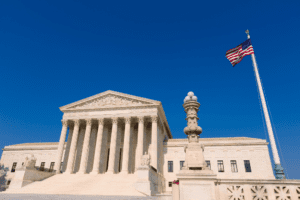 The dissent continued “Whether an applicant meets these proper cause standards is determined in the first instance by a “licensing officer in the city or county . . . where the applicant resides.” §400.00(3). In most counties, the licensing officer is a local judge. Kachalsky, 701 F. 3d, at 87, n. 6. For example, in Rensselaer County, the licensing officer who denied petitioners’ requests to remove the restrictions on their licenses was a justice of the New York Supreme Court. App. 31. If the officer denies an application, the applicant can obtain judicial review under Article 78 of New York’s Civil Practice Law and Rules. Kachalsky, 701 F. 3d, at 87. New York courts will then review whether the denial was arbitrary and capricious. Ibid.
The dissent continued “Whether an applicant meets these proper cause standards is determined in the first instance by a “licensing officer in the city or county . . . where the applicant resides.” §400.00(3). In most counties, the licensing officer is a local judge. Kachalsky, 701 F. 3d, at 87, n. 6. For example, in Rensselaer County, the licensing officer who denied petitioners’ requests to remove the restrictions on their licenses was a justice of the New York Supreme Court. App. 31. If the officer denies an application, the applicant can obtain judicial review under Article 78 of New York’s Civil Practice Law and Rules. Kachalsky, 701 F. 3d, at 87. New York courts will then review whether the denial was arbitrary and capricious. Ibid.
In describing New York’s law, the Court recites the above facts but adds its own gloss. It suggests that New York’s licensing regime gives licensing officers too much discretion and provides too “limited” judicial review of their decisions, ante, at 4; that the proper cause standard is too “demanding,” ante, at 3; and that these features make New York an outlier compared to the “vast majority of States,” ante, at 4. But on what evidence does the Court base these characterizations? Recall that this case comes to us at the pleading stage. The parties have not had an opportunity to conduct discovery, and no evidentiary hearings have been held to develop the record. See App. 15–26. Thus, at this point, there is no record to support the Court’s negative characterizations, as we know very little about how the law has actually been applied on the ground.
Consider each of the Court’s criticisms in turn. First, the Court says that New York gives licensing officers too much discretion and “leaves applicants little recourse if their local licensing officer denies a permit.” Ante, at 4. But there is nothing unusual about broad statutory language that can be given more specific content by judicial interpretation. Nor is there anything unusual or inadequate about subjecting licensing officers’ decisions to arbitrary-and-capricious review. Judges routinely apply that standard, for example, to determine whether an agency action is lawful under both New York law and the Administrative Procedure Act. See, e.g., N. Y. Civ. Prac. Law Ann. §7803(3) (2021); 5 U. S. C. §706(2)(A). The arbitrary-and-capricious standard has thus been used to review important policies concerning health, safety, and immigration, to name just a few examples. See, e.g., Biden v. Missouri, 595 U. S. ___, ___ (2022) (per curiam) (slip op., at 8); Department of Homeland Security v. Regents of Univ. of Cal., 591 U. S. ___, ___, ___ (2020) (slip op., at 9, 17); Department of Commerce v. New York, 588 U. S. ___, ___ (2019) (slip op., at 16); Motor Vehicle Mfrs. Assn. of United States, Inc. v. State Farm Mut. Automobile Ins. Co., 463 U. S. 29, 41, 46 (1983).
A fair response to the dissent is that the decision at issue involves a fundamental Second Amendment right. The burden to justify a denial of such a right is not fairly placed on the applicant. Moreover, it is not fair to force the applicant to take on the time and expense of an appeal and to do so under the “arbitrary and capricious” standard that stacks the odds of a successful appeal against the applicant.
